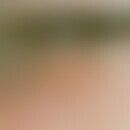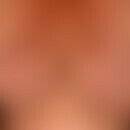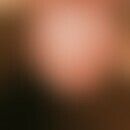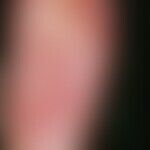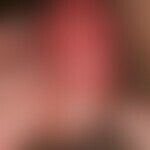Synonym(s)
HistoryThis section has been translated automatically.
Fiessinger & Leroy, 1916; Reiter, 1916
DefinitionThis section has been translated automatically.
Post-infectious, chronic inflammatory systemic disease that occurs as a secondary disease after gastrointestinal or urogenital infections with the classic triad of symptoms (Reiter's triad) consisting of:
- Urethritis (post-urethritic ReA after gonorrhea or non-gonorrheal urethritis, e.g. caused by chlamydia or mycoplasma) or enteritis (post-enteritic ReA after infections caused by Yersinein, Salmonella, Shigella, Camphylobacter jejuni)
- conjunctivitis
- Reactive arthritis.
If Reiter's pustulosis is present, this is referred to as Reiter's tetrad!
Oligosymptomatic courses are not uncommon. The relationship to (pustular) psoriasis is controversial.
You might also be interested in
Occurrence/EpidemiologyThis section has been translated automatically.
Incidence: 3-5/100,000 population/year. The incidence after nonspecific urethritis or shigella enteritis is about 1%, but in carriers of HLA antigen-B27(HLA-B27)it is >20%.
EtiopathogenesisThis section has been translated automatically.
Unexplained. Genetic factors (familial clustering) and association with HLA-B27 (positive in 70-80% of patients) are discussed. Possible infectious allergic reaction after urethritic or enteritic (about 25%) infections with e.g. mycoplasma, yersinia, chlamydia, neisseria gonorrhoeae, viruses. A special etiological feature is post-COVID reactive arthritis.
ManifestationThis section has been translated automatically.
ClinicThis section has been translated automatically.
Onset usually 10-30 days after enteritic or urethritic infection.
Classic triad of symptoms ("can`t see, can`t pee, can`t climb a tree"):
- Urethritis: Usually begins with acute, non-specific, purulent to bloody-purulent discharge, pain on urination. In dysenteric form only secondary urethritis.
- Conjunctivitis: Mostly bilateral with varying degrees of severity.
- Arthritis: Oligoarthritis, especially of the lower extremities, e.g. the knee and ankle joints. Frequently symmetrical, alternating affection with swollen, warm joints that are painful on movement. More rarely, the costosternal joints are also affected. The arthritis of Reiter's disease heals only very slowly.
In addition:
- Integument(25% of Reiter's patients show skin symptoms/Reiter's pustulosis): In particular, there are symmetrical, exudative-pustular, psoriasiform skin changes, especially on Palmae and Plantae(Keratoderma blenorrhagicum), erythemato-squamous-pustular lesions, capillitium and the umbilical region are also affected.
- Nail changes: pustular paronychia, onycholysis, pits, longitudinal corrugations, splitting, nail dystrophy, nail loss, subungual hyperkeratosis.
- Mucous membrane: redness, erythematous macules and papules, erosions, hemorrhages, exfoliatio areata linguae
- Urogenital: Balanitis parakeratotica circinata, chronic prostatitis, cystitis, pyelonephritis.
- Eyes: eyelid and corneal edema, keratitis, iritis, iridocyclitis, uveitis.
- Joints: tendinitis, fasciitis, synovitis, sacroileitis, ankylosing spondylitis.
A clinical variant is post-COVID-19 reactive arthritis (post-COVID-19 ReA). It can occur at any age and apparently affects both sexes equally. Some post-COVID-10 ReA have arthritis of the small joints, others have a spondyloarthritis phenotype - either with peripheral or axial involvement, while some have only tenosynovitis or dactylitis. The occurrence of inflammatory arthritis after COVID-19 vaccination suggests an analogous pathophysiology. Most patients had no associated extra-articular manifestations. A few patients reported associated psoriasis, bilateral conjunctivitis, myalgia, balanitis and symmetrical vasculitis. Additional symptoms such as fever, cough, nausea, diarrhea and taste disturbance occurred irregularly (Bekaryssova D et al. 2022).
LaboratoryThis section has been translated automatically.
Differential diagnosisThis section has been translated automatically.
General therapyThis section has been translated automatically.
External therapyThis section has been translated automatically.
Balanitis: Therapy of balanitis parakeratotica circinata with drying measures such as lotio alba and application of gauze compresses. In addition, application of glucocorticoid-containing creams/lotions such as 0.25% prednicarbate cream(e.g. Dermatop cream), 0.1% methylprednisolone cream (e.g. Advantan) or 0.5% hydrocortisone cream.
Keratoderma blenorrhagicum or/and psoriasiform skin lesions: Medium-strength glucocorticoids such as 0.1% triamcinolone cream triamcinolone acetonide cream hydrophilic 0.025/0.05/0.1% (NRF 11.38.) or 0.1% mometasone furoate (e.g. Ecural fat cream/ointment®), in combination with calcipotriol-containing externals (e.g. Psorcutan ointment®) 2 times/day.
Radiation therapyThis section has been translated automatically.
Internal therapyThis section has been translated automatically.
Intestinal or urethral infection: If urethral or intestinal infection is still detectable , antibiotic therapy with doxycycline (e.g. Doxy Wolff) 2 times 100 mg/day for 7 days.
Arthritis: non-steroidal anti-inflammatory drugs such as acetylsalicylic acid 2-4 g/day (e.g. Aspirin Tbl.), in particular also indomethacin (e.g. Ammuno) 75-150 mg/day, diclofenac (e.g. Voltaren) 75-150 mg/day, ibuprofen (e.g. Ibuprofen-ratiopharm) 600-1200 mg/day.
If necessary, also use systemic glucocorticoids, e.g. prednisolone (e.g. Decortin H Tbl.) initially 100 mg/day, reducing to the lowest possible maintenance dose. If necessary, combination therapy with azathioprine (e.g. Imurek 50), starting with 100 mg/day. Reduction depending on the acuteity and course of the disease.
Remember! Exclude HIV infection before using cytostatics or immunosuppressants, as Reiter's disease can be an expression of a late stage of HIV infection (0.5-11% of patients)!
Once these options have been exhausted, methotrexate (e.g. Methotrexate Lederle) once a week 7.5-15 mg p.o. (is preferable to long-term peroral administration of glucocorticoids). An attempt at therapy is also possible with retinoids such as acitretin (neotigason) 30-50 mg/day (in women only under strict anticonception)!
Ciclosporin A (Sandimmun) is also indicated for the most severe skin and mucous membrane changes. See also psoriasis vulgaris, psoriasis pustulosa generalisata or psoriasis arthropathica.
Good therapeutic success is achieved with the use of TNF-alpha antagonists . They are now considered to be the first choice of therapy.
Progression/forecastThis section has been translated automatically.
In the majority of patients, the disease is "self-limiting" (2-6 months). However, some patients develop a chronic course and require immunomodulatory therapy (Jubber A et al. 2021). Rarely, permanent defects persist. Spontaneous recurrences or recurrences triggered by infections are common.
Disease-specific symptoms are still detected in 80% of patients after 5 years.
LiteratureThis section has been translated automatically.
- Bekaryssova D et al. (2022) Reactive arthritis before and after the onset of the COVID-19 pandemic. Clin Rheumatol 41:1641-1652.
- Catteral RD (1983) Clinical aspects of Reiter's disease. Br J Rheumatol 22: 151
- Edirisinghe DN et al. (2002) Reiter's syndrome and keratoderma blennorrhagica on glans penis--is this unusual? Int J STD AIDS 13: 133-134
- Fiessinger N, Leroy E (1916) Contribution à l'étude d'une épidemie de dysenterie dans la somme. Bull Soc méd Hòp (Paris) 40: 2030
- Fox R, Calin A, Gerber R, Gibson D (1979) The chronicity of symptoms and disability in Reiter's syndrome: an analysis of 131 consecutive patients. Ann Intern Med 91: 190
- García-Kutzbach A et al (2018) Reactive arthritis: update 2018. Clin Rheumatol 37:869-874.
- Gaylis N (2003) Infliximab in the treatment of an HIV positive patient with Reiter's syndrome. J Rheumatol 30: 407-411
- Jubber A et al. (2021) Reactive arthritis: a clinical review. J R Coll Physicians Edinb 51:288-297.
- Kiss S, Letko E et al. (2003) Long-term progression, prognosis, and treatment of patients with recurrent ocular manifestations of Reiter's syndrome. Ophthalmology 110: 1764-1769
- Lotery HE et al. (2003) Ulcerative vulvitis in atypical Reiter's syndrome. J Am Acad Dermatol 48: 613-616
- Reiter H (1916) On a previously unrecognized spirochete infection (spirochaetosis arthritica). Dtsch med Wschr 42: 1535
- Schneider JM et al (2003) Reiter's syndrome. Cutis 71: 198-200
- Wollina U et al. (1999) Nail changes in rheumatic disease. Dermatology 50: 549-555
- Wu IB et al. (2008) Reiter`s syndrome: the classic triad and more. J Am Acad Dermatol 59: 113-121
- Zeidler H et al. (2022) Quo vadis reactive arthritis? Curr Opin Rheumatol 34:218-224.
Incoming links (19)
Aa-type amyloidosis; Ankylosing spondylitis; Balanitis parakeratotica circinata; Conjunctivitis; Dermatitis-arthritis syndromes; Eye diseases, skin changes; Fiessinger-leroy reiter disease; Fiessinger-leroy syndrome; HLA-B27; Hydrocortisone cream hydrophilic 0.25/0.5 or 1% (nrf 11.36.); ... Show allOutgoing links (45)
Acetylsalicylic acid; Acitretin; Acrodermatitis continua suppurativa; Analgesics; Ankylosing spondylitis; Anonychie acquired; Antibiotics; Azathioprine; Balanitis parakeratotica circinata; Calcipotriol; ... Show allDisclaimer
Please ask your physician for a reliable diagnosis. This website is only meant as a reference.
